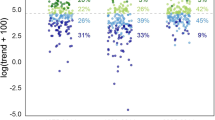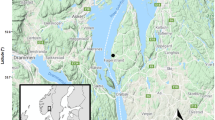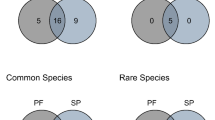Abstract
The Rothamsted Insect Survey has operated a Great Britain-wide network of light-traps since 1968. From these data we estimated the first ever national abundance indices and 35-year population trends for 338 species of common macro-moths. Although the number of trap sites which run each year is not constant, there is a representative, well-distributed core of traps that have run for ≥ 15 years. The proportion of operating sites catching a species and the annual geometric mean catch of successful traps were used to provide estimates of species range and absolute abundance. T, an index of long-term population trends, was used to compare trends among species. T was not biased by trap site turnover. The percentage of species displaying significant decreases (54%) was more than double that displaying increases (22%). Species found throughout Great Britain are decreasing most rapidly in the south and especially the southeast but species with a southerly distribution are increasing. Results of a preliminary overview suggest habitat and climate change may both play a role in changing species dynamics. The existence of estimates of abundances and trends for such a large species pool opens the way for much further research, linking trends with land-use changes, climate change and inter-specific dynamics.
Similar content being viewed by others
References
Andrewartha H. G. and Birch L. C. 1954. The Distribution and Abundance of Animals. University of Chicago Press, Chicago.
Asher J., Warren M., Fox R., Harding P., Jeffcoate G. and Jeffcoate S. 2001. The Millennium Atlas of Butterflies in Britain and Ireland. Oxford University Press, Oxford.
Blasius B., Huppert A. and Stone L. 1999. Complex dynamics and phase synchronization in spatially extended ecological systems. Nature 399: 354–359.
Conrad K. F., Perry J. N. and Woiwod I. P. 2001. An abundance-occupancy time-lag during the decline of an Arctiid tiger moth. Ecol. Lett. 4: 300–303.
Conrad K. F., Woiwod I. P. and Perry J. N. 2002. Long-term decline in abundance and distribution of the garden tiger moth (Arctia caja) in Great Britain. Biol. Conserv.106: 329–337.
Conrad K. F., Woiwod I. P. and Perry J. N. 2003. East Atlantic teleconnection pattern and the decline of a common Arctiid moth. Glob. Change Biol. 9: 125–130.
Cowley M. J. R., Thomas C. D., Thomas J. A. and Warren M. S 1999. Flight areas of British butterflies: assessing species status and decline. Proc. Roy. Soc. Lond. (B)266: 1587–1592.
Dennis R. L. H. 1993. Butterflies and Climate Change, 1st ed Manchester University Press, Manchester.
Donald P. F., Green R. E. and Heath M. M. 2001. Agricultural intensi cation and collapse of Europe's farmland bird populations. Proc. Roy. Soc. Lond. (B)268: 25–29.
Earn D. J. D., Rohani P. and Grenfell B. 1998. Persistence, chaos and synchrony in ecology and epidemiology. Proc Roy. Soc. Lond. (B)265: 7–10.
Emmet A. M. 1991. Life history and habits of the British Lepidoptera. In: Emmet A. M. and Heath J.(eds), The Moths and Butterflies of Great Britain and Ireland. Harley Books, Colchester, pp. 61–203.
Gaston K. J. 1999. Implications of interspeci c and intraspeci c abundance-occupancy relationships. Oikos 86: 195–207.
Gaston K. J., Blackburn T. M., Greenwood J. J. D., Gregory R. D., Quinn R. M. and Lawton J. H. 2000. Abundance-occupancy relationships. J. Appl. Ecol.37: 39–59.
Gaston K. J., Blackburn T. M. and Gregory R. D. 1998. Interspecific differences in intraspeci c abundance-range size relationships of British breeding birds. Ecography 21: 149–158.
Gaston K. J. and Curnutt J. L. 1998. The dynamics of abundance-range size relationships. Oikos 81: 38–44.
Gilbert O. L. 1992. Lichen reinvasion with declining air pollution. In: Bates J. W. and Farmer A. M.(eds), Bryophytes and Lichens in a Changing Environment. Oxford Science Publications, London, pp. 159–177.
Haines-Young R. 2000. Countryside Survey 2000 – Accounting for Nature: Assessing Habitats in the UK Countryside. Department of the Environment, Transport and the Regions, London.
Hanski I. 1999. Metapopulation Ecology. Oxford University Press, Oxford, UK.
Hill J. K., Collingham Y. C., Thomas C. D., Blakeley D. S., Fox R., Moss D. and Huntley B. 2001a. Impacts of landscape structure on butterfly range expansion. Ecol. Lett. 4: 313–321.
Hill J. K., Thomas C. D., Fox R., Moss D. and Huntley B 2001b. Analysing and modelling range changes in UK butterflies. In: Woiwod I. P., Reynolds D. R. and Thomas C. D. (eds), Insect Movement: Mechanisms and Consequences CABI Publishing, Wallingford, pp. 415–441.
Hill J. K., Thomas C. D. and Huntley B. 1999. Climate and habitat availability determine 20th century changes in a butterfly's range margin. Proc. Roy. Soc. Lond. (B). 266: 1197–1206.
Leinonen R., Soderman G., Itamies J., Rytkonen S. and Rutanen I. 1998. Intercalibration of different light-traps and bulbs used in moth monitoring in Northern Europe. Entomol. Fenn. 9: 37–51.
Leon-Cortes J. L., Cowley M. J. R. and Thomas C. D. 1999 Detecting decline in a formerly widespread species: how common is the common blue butterfly Polyommatus icarus? Ecography 22: 643–650.
Leon-Cortes J. L., Cowley M. J. R. and Thomas C. D. 2000. The distribution and decline of a widespread butterfly Lycaena phlaeas in a pastoral landscape. Ecol. Entomol.25: 285–294.
Luff M. L. and Woiwod I. P. 1995. Insects as indicators of land use change: a European perspective, focusing on moths and ground beetles. In: Harrington R. and Stork N. E.(eds), Insects in a Changing Environment. Academic Press, London, pp. 399–422.
McCullagh P. and Nelder J. A. 1989. Generalized Linear Modelling, 2nd ed. Chapman and Hall, London.
Moran P. A. P. 1953. The statistical analysis of the Canadian lynx cycle. Aust. J. Zool.1: 291–298.
Nicholson A. J. 1933. The balance of animal populations. J Anim. Ecol. 2: 132–178.
Ormerod S. J. and Watkinson A. R. 2000. Birds and agriculture – editor's introduction. J. Appl. Ecol.37: 699–705.
Pannekoek J. and Van Strien A. J. 2001. Trim 3 Manual (TRends & Indices for Monitoring data). Statistics Netherlands, Voorburg.
Parmesan C. 2001. Coping with modern times?Insect movement and climate change. In: Woiwod I. P., Reynolds D. R and Thomas C. D.(eds), Insect Movement: Mechanisms and Consequences. CABI Publishing, Wallingford, pp. 387–413.
Parmesan C., Ryrholm N., Stefanescu C., Hill J. K., Thomas C. D., Descimon H., Huntley B., Kaila L., Kullberg J., Tammaru T., Tennent W. J., Thomas J. A. and Warren M 1999. Poleward shifts in geographical ranges of butterfly species associated with regional warming. Nature 399: 579–583.
Perry J. N., Woiwod I. P. and Hanski I. 1993. Using response-surface methodology to detect chaos in ecological time series Oikos 68: 329–339.
Pollard E., Moss D. and Yates T. J. 1995. Population trends of common British butterflies at monitored sites. J. Appl. Ecol. 32: 9–16.
Pollard E. and Yates T. 1993. Monitoring Butterflies for Ecology and Conservation, 1st ed. Chapman and Hall, London.
Pullin A. S. ed. 1995. Ecology and Conservation of Butterflies, 1st ed. Chapman and Hall, London.
Ranta E., Kaitala V. and Lundberg P. 1997. The spatial dimension in population fluctuations. Science 278: 1621–1623.
Roy D. B., Rothery P., Moss D., Pollard E. and Thomas J. A 2001. Butterfly numbers and weather: predicting historical trends in abundance and the future effects of climate change J. Anim. Ecol.70: 201–217.
Royama T. 1992. Analytical Population Dynamics, 1st ed Chapman and Hall, London.
Stevens C. J., Dise N. B., Mountford J. O. and Gowing D. J 2004. Impact of nitrogen deposition on the species richness of grasslands. Nature 303: 1876–1879.
Taylor L. R. and French R. A. 1974. Effects of light-trap design and illumination on samples of moths in an English woodland. Bull. Ent. Res.63: 583–594.
Taylor L. R. and Woiwod I. P. 1982. Comparative synoptic dynamics I. Relationships between inter- and intra-specific spatial and temporal variance/mean population parameters J. Anim. Ecol.51: 879–906.
Taylor L. R., Woiwod I. P. and Perry J. N. 1978. The density-dependence of spatial behaviour and the rarity of randomness. J. Anim. Ecol.47: 383–406.
Thomas C. D. and Abery J. C. G. 1995. Estimating rates of butterfly decline from distribution maps – the effect of scale Biol. Conserv.73: 59–65.
Thomas C. D. and Lennon J. J. 1999. Birds extend their ranges northwards. Nature 399: 213.
Thomas J. A. 1995. The conservation of declining butterfly populations in Britain and Europe: priorities, problems and successes. Biol. J. Linn. Soc.56: 55–72.
Thomas J. A., Telfer M. G., Roy D. B., Preston C. D., Greenwood J. J. D., Asher J., Fox R., Clarke R. T. and Lawton J. H 2004. Comparative losses of British butterflies, birds, and plants and the global extinction crisis. Science 303: 1879–1881.
Turner J. R. G., Gatehouse C. M. and Corey C. A. 1987. Does solar-energy control organic diversity – butterflies, moths and the British climate. Oikos 48: 195–205.
Van Strien A. J., Pannekoek J. and Gibbons D. W. 2001 Indexing European bird population trends using results of national monitoring schemes: a trial of a new method. Bird Study 48: 200–213.
Waring P., Townsend M. and Lewington R. 2003. Field Guide to the Moths of Great Britain and Ireland, 1st ed. British Wildlife Publishing, Hook, UK.
Warren M. S. 1993a. A review of butterfly conservation in central southern Britain. 1. Protection, evaluation and extinction on prime sites. Biol. Conserv.64: 25–35.
Warren M. S. 1993b. A review of butterfly conservation in central Southern Britain. 2. Site management and habitat selection of key species. Biol. Conserv.64: 37–49.
Warren M. S., Hill J. K., Thomas J. A., Asher J., Fox R., Huntley B., Roy D. B., Telfer M. G., Jeffcoate S., Harding P., Jeffcoate G., Willis S. G., Greatorex-Davies J. N., Moss D. and Thomas C. D. 2001. Rapid responses of British butterflies 135. to opposing forces of climate and habitat change. Nature 414: 65–69.
Williams C. B. 1948. The Rothamsted light-trap. Proc. Roy Ent. Soc. Lond. (A)23: 80–85.
Williams C. B. 1952. Some notes on killing insects for collections and for scienti fi c research. Entomologist 85: 271–279.
Woiwod I. P. 1991. The ecological importance of long-term synoptic monitoring. In: Firbank L. G., Carter N., Darbyshire J. F. and Potts G. R.(eds), The Ecology of Temperate Cereal Fields. Proceedings 32nd Symposium of the British Ecological Society with the Association of Applied Biologists. Blackwell Scienti fi c, Oxford, pp. 275–304.
Woiwod I. P. and Hanski I. 1992. Patterns of density dependence in moths and aphids. J. Anim. Ecol.61: 619–629.
Woiwod I. P. and Harrington R. 1994. Flying in the face of change: the Rothamsted Insect Survey. In: Leigh R. and Johnston A.(eds), Long-term Experiments in Agricultural and Ecological Sciences. CAB International, Wallingford, pp. 321–342.
Young M. R. 1997. The Natural History of Moths. T. & A. D Poyser, London
Author information
Authors and Affiliations
Rights and permissions
About this article
Cite this article
Conrad, K.F., Woiwod, I.P., Parsons, M. et al. Long-term population trends in widespread British moths. Journal of Insect Conservation 8, 119–136 (2004). https://doi.org/10.1023/B:JICO.0000045810.36433.c6
Issue Date:
DOI: https://doi.org/10.1023/B:JICO.0000045810.36433.c6




